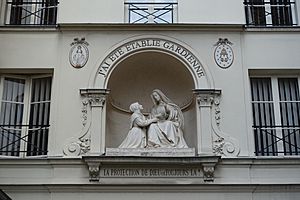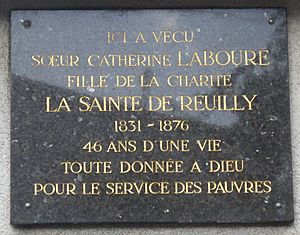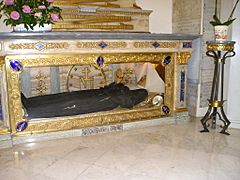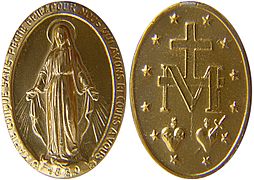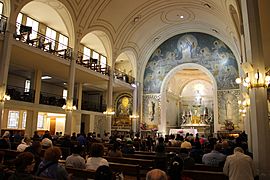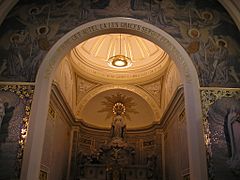Catherine Labouré facts for kids
Quick facts for kids SaintCatherine Labouré D.C. |
|
|---|---|
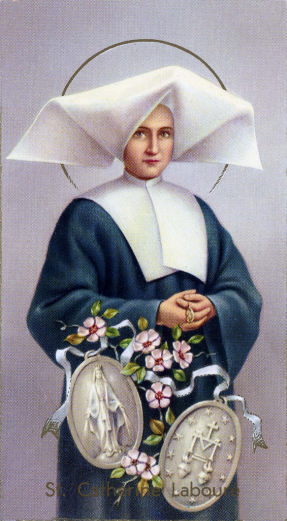 |
|
| Sister of Charity, Marian visionary | |
| Born | May 2, 1806 Fain-lès-Moutiers, Côte-d'Or, France |
| Died | December 31, 1876 (aged 70) Reuilly Paris, France |
| Venerated in | Roman Catholic Church |
| Beatified | May 28, 1933, Vatican by Pope Pius XI |
| Canonized | July 27, 1947, Vatican by Pope Pius XII |
| Major shrine | Chapel of Our Lady of the Miraculous Medal, Paris, France |
| Feast | 28 November 31 December |
| Attributes | Daughters of Charity habit, Miraculous Medal |
| Patronage | Miraculous Medal, the infirm, the elderly |
Saint Catherine Labouré (born May 2, 1806 – died December 31, 1876) was a French nun. She belonged to a group called the Daughters of Charity of Saint Vincent de Paul. Catherine is famous because she said the Blessed Virgin Mary appeared to her. These visions led to the creation of the well-known Miraculous Medal. Millions of people around the world wear this medal. Catherine Labouré spent 40 years helping sick and elderly people. Because of her dedication, she is known as the patroness of seniors.
Contents
Catherine's Early Life
Catherine Labouré was born on May 2, 1806, in the Burgundy region of France. Her father, Pierre Labouré, was a farmer. Catherine was the ninth of 11 children. Her baptismal name was Zoe, but her family usually called her Catherine.
When Catherine was nine years old, her mother died. After the funeral, it is said that Catherine picked up a statue of the Blessed Virgin Mary. She kissed it and said, "Now you will be my mother."
Catherine and her sister Marie Antoinette then went to live with their aunt. Their aunt lived in a village called Saint-Rémy, Côte-d'Or. While there, Catherine had a dream about a priest. She later realized this priest was Vincent de Paul. In her dream, he told her that God had plans for her. He said she would one day be happy to help the sick.
At age 12, Catherine went back to her father's farm. She helped care for her family. Later, her father sent her to Paris to work in his brothers' restaurant. This was a place for poor workers. Seeing their struggles made Catherine even more determined. She wanted to join the Daughters of Charity. This was a nursing order founded by Saint Vincent de Paul.
Catherine began her training as a nun on April 21, 1830. She was at the convent on the rue du Bac in Paris. On January 30, 1831, she took her vows. It was at this convent that she had the visions of the Virgin Mary. These visions led to the creation of the Miraculous Medal.
Visions of Saint Catherine
Catherine Labouré reported having several important visions. These experiences deeply influenced her life and the Catholic Church.
Vision of Vincent de Paul
In April 1830, the remains of Vincent de Paul were moved to a church in Paris. During this time, Catherine said she saw visions of Vincent de Paul's heart. This happened three evenings in a row. Each time, his heart appeared a different color: white, red, and black. Catherine believed this meant good things for the Vincentian communities. She also thought it meant there would be a change in government. Her priest told her to try and forget about it.
Visions of the Blessed Virgin Mary
Catherine Labouré said that on July 19, 1830, she woke up after hearing a child's voice. The voice called her to the chapel. There, she heard the Virgin Mary speak to her. Mary told her, "God wishes to give you a mission. You will face challenges, but do not be afraid. You will have the strength to do what is needed. Tell your spiritual guide everything that happens to you. Times are difficult in France and in the world."
On November 27, 1830, Catherine reported another vision. The Blessed Mother appeared to her during evening prayers. Mary stood inside an oval frame, on top of a globe. Rays of light came from her hands towards the globe. Around the edge of the frame were the words: "O Mary, conceived without sin, pray for us who have recourse to thee."
As Catherine watched, the frame seemed to turn. On the back, she saw a circle of twelve stars. There was also a large letter M with a cross above it. Below the M were the Sacred Heart of Jesus and the Immaculate Heart of Mary. Catherine asked why some of the light rays did not reach the earth. Mary reportedly replied, "Those are the graces for which people forget to ask."
Mary then asked Catherine to take these images to her priest. She told him that these images should be put on medallions. Mary said, "All who wear them will receive great graces."
Catherine told her priest about the visions. After two years of checking and observing Catherine, the priest shared the information. He did not tell anyone Catherine's name. The request was approved. A French goldsmith named Adrien Vachette was asked to make the medallions.
These medallions became very popular. They were called the Miraculous Medal. Millions of Catholic people quickly adopted them. The medal also played a role in Pope Pius IX's declaration. He officially announced the Immaculate Conception on December 8, 1854. The medal, with its message "conceived without sin," helped people accept this idea.
Helping the Poor and Elderly
After taking her vows, Catherine Labouré was sent to the Hospice d'Enghien. This was a place for the sick and elderly. It was located in the village of Reuilly, just outside Paris. She spent the next 40 years of her life there. She cared for the elderly and those who were ill. This is why she is called the patroness of seniors.
During her time at the hospice, she did many tasks. She not only cared for the sick but also worked on the farm. She looked after the chickens and cleaned the stables. Catherine's life was known for her strong dedication to the poor and elderly. She was also known for her humble nature and quiet devotion.
Death and Legacy
Catherine Labouré died at the Hospice on December 31, 1876. She was 70 years old. Her body was later moved. It is now in a glass case beneath an altar. This is in the Chapel of Our Lady of the Miraculous Medal in Paris.
Her journey to sainthood began when her body was found to be incorrupt. This means it had not decayed naturally. She was declared "blessed" on May 28, 1933, by Pope Pius XI. She was made a saint on July 27, 1947, by Pope Pius XII.
Catherine Labouré's feast day is celebrated on November 28. This is according to the calendar of the Congregation of the Mission and the Daughters of Charity of Saint Vincent de Paul. She is also listed in the Roman Martyrology for December 31.
Gallery
See also
 In Spanish: Catalina Labouré para niños
In Spanish: Catalina Labouré para niños




